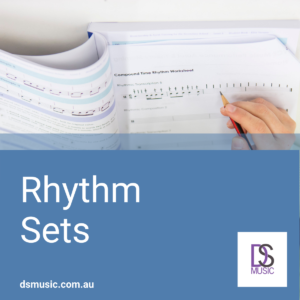Step-by-step tips for getting better at rhythmic dictation.
Comments Off on Step-by-step tips for getting better at rhythmic dictation.A question I often get asked by students – especially in the lead up to exams! – is how to do dictations. Here at DSMusic, we’re big on really knowing these concepts, whether it’s scales or intervals, or chords or rhythm.
It’s important to remember that everything you’re doing in a music language space is actually to make you a better musician, not just to pass the next test! So let’s work through some ways to get better at rhythmic dictations, as well as the steps I use.

Sightread lots of rhythms.
This might seem like a simple step but it’s an important one. The more you’re sightreading rhythms – trying to read them for the first time – the more you’ll be able to dictate them. Ideally, rhythms need to be read in rhythm names as this system can be carried across a variety of different groupings and time signatures. An even better extra step is adding conducting to this as well, strengthening both the reading of rhythm and your sense of pulse.
Recognise & Recreate.
Beyond sightreading, we also need to make sure we understand what sorts of things we can expect. As in, analysing and understanding the content, format and structure of rhythms so we’re better able to recognise them. Though this is something that develops through sightreading, as mentioned above, it’s also a great opportunity to get creative. Composing rhythmic ideas takes what you’re hearing and understanding and consolidates it, enhancing your ability to recognise and recreate.
DSMusic Top Tip: Don’t limit your playings – use as many as you need while you’re building this skill.

Rhythm Sets.
Once you know what to ‘expect’ rhythmically, this helps narrow down your options in a dictation exercise. Rhythm sets are your go-to-guide – they’re all the rhythmic groupings your ears might have to recognise. Noting them down quickly on some manuscript or blank paper before the dictation aids in the process, particularly if you can check a Study Design page for the exact rhythms that can be used. This is also very important preparation for your rhythmic shorthand – and translating how many sounds you heard into the appropriate rhythmic grouping.
Rhythmic Dictation Steps.
Okay, so now we’ve spoken through what you should do to prepare yourself for rhythmic dictation, let’s go over the steps themselves. Remember, this is what works for me so feel free to adjust or ignore – find the approach that best suits you!
- Write your rhythm set – it might be three rhythmic groupings or many more, but it’s your first step!
- Setup your rhythm shorthand above the staff – this would be a single beat stroke in simple time, or beat and pulse strokes in compound time.
- Listen to the rhythm, pointing at your beat/pulse strokes.
- Add rhythmic shorthand for each sound you hear on a beat/pulse – e.g. two lines for two sounds.
- If needed, translate your shorthand onto the staff – try to do this before the last playing.
- For the last playing, listen through and check your answers – remember, try not to leave things blank, use your preparation and understanding of rhythms and guess!
How can DSMusic resources support you?
We’ve got a ready-made Rhythm Set resource for you, so just access it by clicking the image on the right and adjust as much as you need!
Are you in VCE Music? Get yours on this page!
If you’re seeking more support for this step-by-step approach, here’s some free DSMusic videos:
And remember…
There’s no silver bullet when it comes to building these skills – no overnight cramming possible! You have to consistently and sequentially give time and attention to developing your awareness, understanding and confidence.
Happy rhythm-recognising, everyone! – Deb



Comments are closed